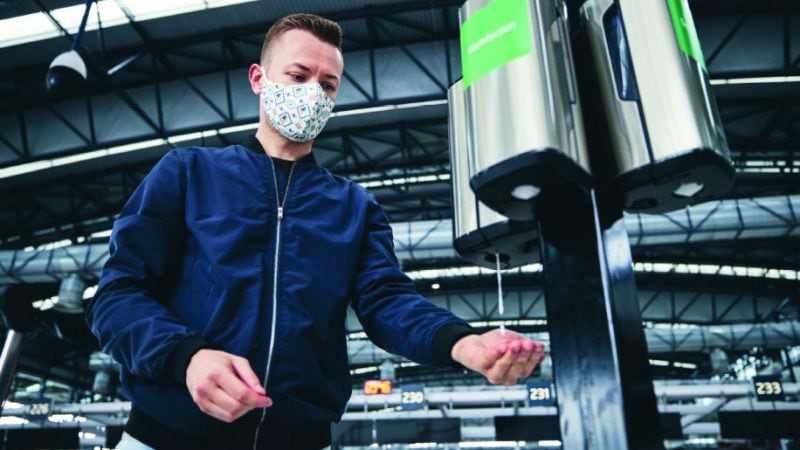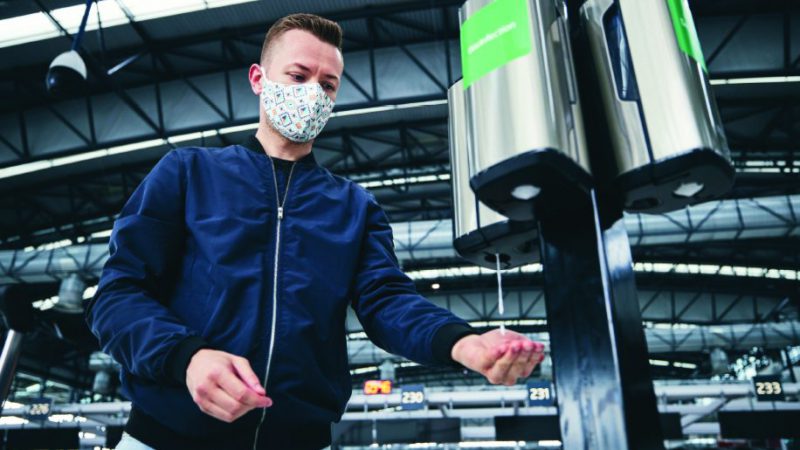Travel Comes Clean
As the coronavirus pandemic lingers, travel providers are spinning out new measures every day to counter the threat
July 1, 2020


Proximity and duration are the two factors that crop up in most discussions of the likely spread of COVID-19. The closer you are to someone infected with the coronavirus plus the longer the time you spend near them, the more likely you are to become infected yourself.
According to the Centers for Disease Control and Prevention, the greatest COVID-19 risk is being around breathing, laughing, coughing, sneezing, talking people. And where are people shoehorned into crowded spaces for long periods of time?
Airplanes.
While leisure travelers think they can afford to discount the risk, business travel has come to a virtual standstill.
“Business travelers won’t return in force until their travel managers and senior management are confident that employees’ health safety can be protected,” says Henry H. Harteveldt, travel industry and consumer analyst, researcher and co-founder of Atmosphere Research Group. An employer has a responsibility to ensure that the employee is able to get to and from a destination safely. “That ‘duty of care’ extends to health safety with the coronavirus still very active,” Harteveldt notes.
Air On the Side of Caution
All airlines and airports have instituted more rigorous cleaning methods. The Tampa International Airport (TPA) in Florida has launched “TPA Ready” addressing social distancing, mask usage, plastic shield barriers, surface disinfection, and touchless transactions, all designed to slow or stop the spread of germs and viruses.
The shields are being installed in key high-traffic areas, including ticket counters, TSA security checkpoints, boarding gate, and concessions counters. Social distancing markers have been placed on the floor by ticket counters, boarding gates, and other common areas. Terminal seating has been reduced, and all employees are required to wear face masks.
Airlines are trying to mitigate the risks of sharing respiratory droplets by requiring face masks, but anecdotal reports of most airplane passengers flying bare-faced are everywhere on social media, prompting the industry to tighten face covering requirements.
As this goes to press, Airlines for America has issued new directives for member airlines to insist on passenger compliance with mask rules, and imposing consequences for failure to comply, up to and including suspension of flying privileges. To supplement customer-provided masks, the Department of Transportation is distributing 100 million face coverings to airports, rail hubs and transit agencies.
On Delta, face masks are required starting at the check-in lobby and across Delta “touchpoints” including Sky Clubs, boarding gate areas, jet bridges, and on board the aircraft for the duration of the flight. All flights now board from back to front. And most recently, the airline has established a Global Cleanliness division under its customer experience department.
In a memo sent June 11 to Delta SkyMiles members, CEO Ed Bastian promised, “Through September 30, you can rest assured that you won’t board a full plane, as our seating capacity is capped at 60 percent and middle seats are blocked to allow space for safer travel. This ensures you will have an empty seat next to you on every Delta flight.”
United Airlines will provide facemasks to passengers who arrive at the airport without them, and stages boarding from back to front. United also has partnered with both Clorox and the Cleveland Clinic to monitor the efficacy of cleaning procedures used. In accordance with guidance set forth by the clinic, United now requires passengers – before receiving a boarding pass — to complete a Ready-to-Fly checklist, and click or verbally “accept,” including confirmation that they have not experienced COVID-19-related symptoms in the 14 days prior to flying.
In addition to tightening up on face mask policy, Southwest too has launched its own Customer Health Declaration pre-boarding form and vowed to keep middle seats empty through September.
JetBlue has committed to blocking middle seats on larger aircraft, and aisle seats on smaller. Alaska Airlines provides face masks for passengers. In addition, through July 31, middle seats on Alaska Airlines are blocked, and flights will be capped at 65 percent capacity to allow for extra space between guests not traveling together.
Amenities also have disappeared in flight: No more beverage cart, snacks or meals. The most passengers can expect onboard is a small bottle of water and, perhaps, a packaged snack, and on shorter flights, they won’t get even that minimum.
Taking It Personally
Marc Pablo, director of quality assurance at California Transplant Services, is a business traveler who hasn’t been on an airplane since March. “If it’s 600 miles or less, I drive,” he notes. “I’ve got to be careful, because I am in three high-risk groups for coronavirus: I’m 59, I have diabetes and I’m overweight.”
Although he can avoid planes, he still has to stay overnight in hotels. Before Pablo brings his suitcase into the room, he runs through a rigorous sanitation routine with his own supply of cleaning products, including Lysol liquid and spray, a roll of paper towels, and his own trash bags. After cleaning the sleeping area and bathroom, he then goes back to his car to fetch his suitcase, bringing it in on his own cart and never unpacking. He travels with his own bed pillow.
Because his medical services business retrieves and stores body tissues for living patients in trauma centers, he visits hospitals daily. Pablo notes that their protocols have changed, too. To be admitted as a vendor, he has to be in the hospital’s database, set up a timed appointment in advance, have his temperature checked on arrival, and be screened for “all the normal COVID questions.”
Hotels have erected plastic shields at check-in desks and put face masks on their staff. They tout their efforts at stepping up their cleaning routines to mitigate possible routes of contagion. Most have eliminated once-expected amenities – including that chocolate mint on the pillow, the minibar, the coffee maker in the room and even paper memo pads, pens and guest directories.
Glasses in the bathroom are now all disposable, and television remotes sometimes are encased in plastic bags. The push toward eco-friendly large bottles of soap and shampoo has been replaced with individual-use amenities.
If pools and exercise rooms are open, they’re limited in capacity and cleaned more often. “Elevator lines” have been instituted in larger properties to reduce crowding.
Expansive breakfast buffets? Most are gone. Some hotels have stacks of boxed meals at the ready each morning, while others allow only cooked-to-order meals. Shared coffee and juice stands are gone.
Hotels Come Clean
The American Hotel and Lodging Association has developed “Stay Safe,” a series of cleaning guidelines for the industry in response to COVID-19 that cover both employees and guests. For example, elevator button panels and handrails should be disinfected at regular intervals, including the beginning of each housekeeping staff work shift and continuing throughout the day. Traditional room service should be replaced with a no-contact delivery method.
Red Roof Inns promise new “RediClean” protocols in guest rooms. In addition, “up to four times per day,” housekeepers are sanitizing exterior and corridor touchpoints as well as common areas “including elevators, laundry rooms, front desks, maintenance rooms, storage door handles, stairwell handrails, emergency exit doors, pool gates (if applicable), dumpster gate handles and trash receptacles and carts, and public restrooms”. Accor will provide guests with face masks.
Hilton boasts of “CleanStay with Lysol Protection” procedures, and has announced a partnership with the Mayo Clinic for advice and assistance on cleaning disinfection protocols. Marriott has created a Global Cleanliness Council to “to develop a new generation of global hospitality cleanliness standards, norms and behaviors for Marriott’s more than 7,300 properties around the globe.”
Hyatt has introduced GBAC STARTM accreditation, a performance-based cleaning, disinfection, and infectious disease prevention program. (GBAC is a division of ISSA, a global cleaning industry association of companies working in microbial-pathogenic threat analysis and mitigation designed specifically to deal with biological threats and real-time crises like the COVID-19 pandemic.)
Amtrak has tackled the coronavirus threat as a transportation company that also provides overnight accommodations and food service. Ticket sales are limited on reserved services to facilitate social distancing on board. Face masks are required for all customers when they are not in their private rooms or seated alone. Service will be denied to customers not wearing facial coverings.
In addition, there are some train-specific changes. Café service aboard Amtrak trains that still offer food service will be available as carryout only. As seating in the café will be closed, customers will bring items back to their seats or private rooms to eat. Passengers can use an “automatic door open button” with their foot when moving between cars, and conductors will announce where and when passengers can disembark at stops to minimize crowding at the exit doors.
Road warriors have to eat in restaurants. Eating indoors is considered medium to high risk, because people linger there (increasing the duration of any exposure). Hotels are separating tables and enlarging outdoor seating areas (where the risk is considered lower). Menus now tend toward the single-use throw-away. Waitstaff are masked, and single-use condiment packages have replaced catsup bottles and sugar bowls.
With all the emphasis on disinfecting and otherwise cleaning surfaces, travelers should keep in mind that, according to the CDC, the main way people are getting sick with the coronavirus is from airborne respiratory droplets spreading between people in close quarters, and COVID-10 may be spread by people with no symptoms of the disease.




